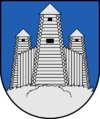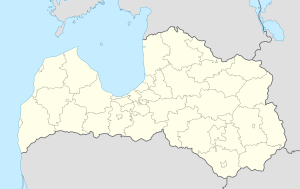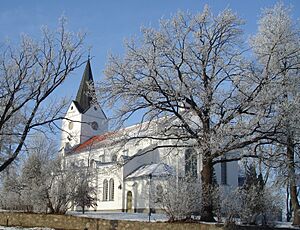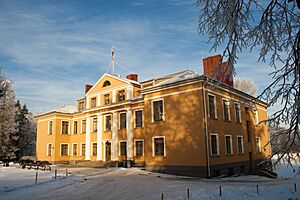Saldus facts for kids
Quick facts for kids
Saldus
|
|||
|---|---|---|---|
|
Town
|
|||
| Saldus | |||
 |
|||
|
|||
| Nickname(s):
Medus piliens Kurzemē
'A drop of honey in Courland' |
|||
| Country | |||
| Municipality | Saldus Municipality | ||
| Town rights | 1917 | ||
| Area | |||
| • Total | Lua error in Module:Wd at line 1,575: attempt to index field 'wikibase' (a nil value). km2 (Formatting error: invalid input when rounding sq mi) | ||
| • Land | Lua error in Module:Wd at line 1,575: attempt to index field 'wikibase' (a nil value). km2 (Formatting error: invalid input when rounding sq mi) | ||
| • Water | Expression error: Unexpected < operator. km2 (Formatting error: invalid input when rounding sq mi) | ||
| Population
(2019)
|
|||
| • Total | 9,937 | ||
| Time zone | UTC+2 (EET) | ||
| • Summer (DST) | UTC+3 (EEST) | ||
| Postal code |
LV-3801
|
||
| Calling code | +371 638 | ||
| Climate | Dfb | ||
| Website | https://www.saldus.lv/ | ||
Saldus is a town in Latvia, located in the Courland region. It is the biggest town in Saldus Municipality. People have known about Saldus since the mid-1200s. However, the town officially started in 1856. It became a recognized town in 1917.
Saldus is located between the cities of Riga and Liepāja. It is a bit closer to Liepāja (100 km) than Riga (119 km). The Ciecere River flows through Saldus. This river is a branch of the Venta, one of Latvia's largest rivers.
Many people call Saldus "the Bowl of Courland." This nickname comes from a famous quote by Māris Čaklais. He said it was "A drop of honey in the bowl of Courland." The town looks like a crater from above, which is why it got this name.
In January 2019, Saldus was the 17th largest city in Latvia. Its population was 9,937 people at that time.
Contents
Discovering Saldus History
Early Beginnings of Saldus
Archaeological studies show that the Baltic tribe called Couronians lived here long ago. They lived in the Saldus area around 2000 BC. Saldus Castle was a strong defense center near Lake Saldus until the 1200s.
The year 1856 is seen as the start of modern Saldus. This is when a group decided to create a trade center here. Even though Saldus had a busy economy and was a cultural hub by the late 1800s, it only became an official town in 1917.
One of the oldest buildings is Saldus St.John's church. Records from 1461 mention a wooden church. It has been rebuilt many times. The church tower was bombed in 1944. It was rebuilt later, from 1981 to 1982.
Saldus During World War II
Before the Nazis invaded, many Jewish people lived in Saldus. Nazi soldiers entered the city on June 29, 1941. They arrested about 100 Jewish men. These men were later killed in the Veide forest, about 1 km from Saldus.
After these arrests, about 200 more Jewish people were held in the local synagogue and prison. They were then taken to Baltezers Lake, 4 km from Saldus. There, they were killed by the Sicherheitsdienst, with help from some local people.
Economy and Culture in Saldus
Business and Trade
Saldus has grown into an important center for culture, education, business, and trade. Around 500 companies operate in Saldus. Their main work is in building, wood processing, and food production.
Arts and Community Life
Today, Saldus also has a very active cultural scene. Many local musicians, poets, painters, and artists live and work here.
The Official Hymn of Saldus
The official song of Saldus is called Saldus saule, which means Saldus Sun. Ēriks Ķiģelis and Māris Čaklais wrote this song.
The song was first released in 1986. On November 18, 2018, 32 years later, it was officially named the city's hymn.
| Lyrics |
|---|
|
Rudenī viņa kā rupjmaize |
Education in Saldus
Saldus has a lively cultural and social life. Education has always been a key part of it. The town has schools that look to the future and honor the past. All schools welcome both boys and girls.
The Saldus School of Music opened in 1946. Later, in 1984, the Saldus Art School was started.
On March 22, 2013, the Saldus Art School moved into a brand new building.
Until 2016, Saldus had two high schools. These were Saldus Gymnasium and Saldus Secondary High School. Saldus Gymnasium closed down in 2016. Saldus Secondary High School was renamed Saldus High School.
Educational Institutions in Saldus
- 6 Pre-school educational centers
- 3 Primary Schools
- Saldus High School
- Vocational High School
- Saldus Art and Music School
Culture and Events in Saldus
Saldus Saule Festival
The yearly Rock festival called 'Saldus Saule' makes Saldus famous. People know about it in Latvia and nearby countries. The first "Saldus Saule" festival happened in 1987. But the idea for it came earlier.
On October 3, 1985, a beloved musician named Ēriks Ķiģelis passed away. Young people at that time wanted to remember him. So, they created the festival. Because of the USSR government, they could not name the festival after Ēriks Ķiģelis directly.
Juris Vilcāns, a well-known music expert, and Ēriks Niedra organized the first festival.
Geography of Saldus
Saldus is located in the ‘Austrumkursas’ Highlands. It is the largest city in this highland area. The city was built on both sides of the ‘Ciecere’ river. On the east side of the city is ‘Saldus lake’. Saldus is known as one of Latvia's greenest cities. It has many parks, squares, and lots of plants.
Many small rivers flow through Saldus. However, only one is very important. Other rivers also have names.
Saldus Lake
Saldus Lake is located north-east of the city, right at its edge. The north-west and south-east shores of the lake are very steep. The lake has an outlet called Vēršāda, which is a branch of a river. It also has a small river flowing into it, called Kaļķupīte. The deepest part of the lake is 5 meters. On the south-west shore, there is a beach made by people.
Ciecere River
The Ciecere River is 51 km long. It flows into the Venta river from the right side. The Ciecere River itself has 52 smaller rivers flowing into it. It starts from Lake Ciecere. For 6 km, it flows through Saldus. This creates a very green area in the city center. There are 14 bridges crossing the river in Saldus. You can also find a few man-made waterfalls here. In the 1600s, ships and boats could travel on this river.
Climate in Saldus
Saldus has a humid continental climate. This type of climate is known as Dfb in the Köppen system.
| Climate data for Saldus (1991-2020 normals, extremes 1945–present) | |||||||||||||
|---|---|---|---|---|---|---|---|---|---|---|---|---|---|
| Month | Jan | Feb | Mar | Apr | May | Jun | Jul | Aug | Sep | Oct | Nov | Dec | Year |
| Record high °C (°F) | 9.4 (48.9) |
12.2 (54.0) |
18.8 (65.8) |
27.1 (80.8) |
29.6 (85.3) |
32.4 (90.3) |
34.3 (93.7) |
33.1 (91.6) |
29.4 (84.9) |
23.8 (74.8) |
16.8 (62.2) |
11.6 (52.9) |
34.3 (93.7) |
| Mean daily maximum °C (°F) | −0.5 (31.1) |
−0.1 (31.8) |
4.1 (39.4) |
11.5 (52.7) |
17.1 (62.8) |
20.3 (68.5) |
22.9 (73.2) |
22.0 (71.6) |
16.9 (62.4) |
10.2 (50.4) |
4.5 (40.1) |
1.0 (33.8) |
10.8 (51.5) |
| Daily mean °C (°F) | −2.6 (27.3) |
−2.7 (27.1) |
0.4 (32.7) |
6.2 (43.2) |
11.5 (52.7) |
15.0 (59.0) |
17.6 (63.7) |
16.7 (62.1) |
12.1 (53.8) |
6.8 (44.2) |
2.4 (36.3) |
−1.0 (30.2) |
6.9 (44.4) |
| Mean daily minimum °C (°F) | −5.2 (22.6) |
−5.5 (22.1) |
−3.3 (26.1) |
1.3 (34.3) |
5.5 (41.9) |
9.5 (49.1) |
12.2 (54.0) |
11.7 (53.1) |
7.9 (46.2) |
3.6 (38.5) |
0.3 (32.5) |
−3.1 (26.4) |
2.9 (37.2) |
| Record low °C (°F) | −34.2 (−29.6) |
−36.2 (−33.2) |
−26.9 (−16.4) |
−12.6 (9.3) |
−4.0 (24.8) |
−1.4 (29.5) |
3.8 (38.8) |
1.8 (35.2) |
−4.2 (24.4) |
−9.4 (15.1) |
−22.5 (−8.5) |
−30.5 (−22.9) |
−36.2 (−33.2) |
| Average precipitation mm (inches) | 48.9 (1.93) |
37.7 (1.48) |
36.8 (1.45) |
35.4 (1.39) |
46.8 (1.84) |
62.0 (2.44) |
83.5 (3.29) |
76.9 (3.03) |
59.4 (2.34) |
68.7 (2.70) |
53.3 (2.10) |
53.2 (2.09) |
662.6 (26.08) |
| Average precipitation days (≥ 1 mm) | 12 | 9 | 9 | 8 | 8 | 10 | 10 | 10 | 10 | 12 | 12 | 12 | 122 |
| Source 1: LVĢMC | |||||||||||||
| Source 2: NOAA (precipitation days 1981-2010) | |||||||||||||
Population Changes in Saldus
The number of people living in Saldus has been going down since the first count. This drop became faster when many people from Latvia chose to move to the United Kingdom.
| Historical population | ||||||||||||||||||||||||||||||||||||||||||||||||||||||||||||||||||||||||||||||||||||||||||||||||||||
|---|---|---|---|---|---|---|---|---|---|---|---|---|---|---|---|---|---|---|---|---|---|---|---|---|---|---|---|---|---|---|---|---|---|---|---|---|---|---|---|---|---|---|---|---|---|---|---|---|---|---|---|---|---|---|---|---|---|---|---|---|---|---|---|---|---|---|---|---|---|---|---|---|---|---|---|---|---|---|---|---|---|---|---|---|---|---|---|---|---|---|---|---|---|---|---|---|---|---|---|---|
|
|
|||||||||||||||||||||||||||||||||||||||||||||||||||||||||||||||||||||||||||||||||||||||||||||||||||
| Source: Central Statistical Bureau of Latvia | ||||||||||||||||||||||||||||||||||||||||||||||||||||||||||||||||||||||||||||||||||||||||||||||||||||
Famous People from Saldus
Many talented people have come from Saldus:
- Johann von Besser (1654–1729) – a German writer
- Janis Rozentāls (1866–1917) – a famous painter
- Oskars Kalpaks (1882–1919) – a military leader
- Lea Davidova-Medene (1921–1986) – a sculptor
- Ursula Donath (born 1931) – a German athlete
- Māris Čaklais (1940–2003) – a poet
- Ēriks Ķiģelis (1955–1985) – a musician
- Jānis Blūms (born 1982) – a basketball player
- Dons (born 1984) – a singer
- Uģis Žaļims (born 1986) – a bobsledder
- Ieva Laguna (born 1990) – a top model
- Gunārs Skvorcovs (born 1990) – an ice hockey player
Saldus Around the World
Twin Towns and Sister Cities
Saldus has special partnerships with other towns around the world. These are called twin towns or sister cities.
Images for kids
See also
 In Spanish: Saldus para niños
In Spanish: Saldus para niños















